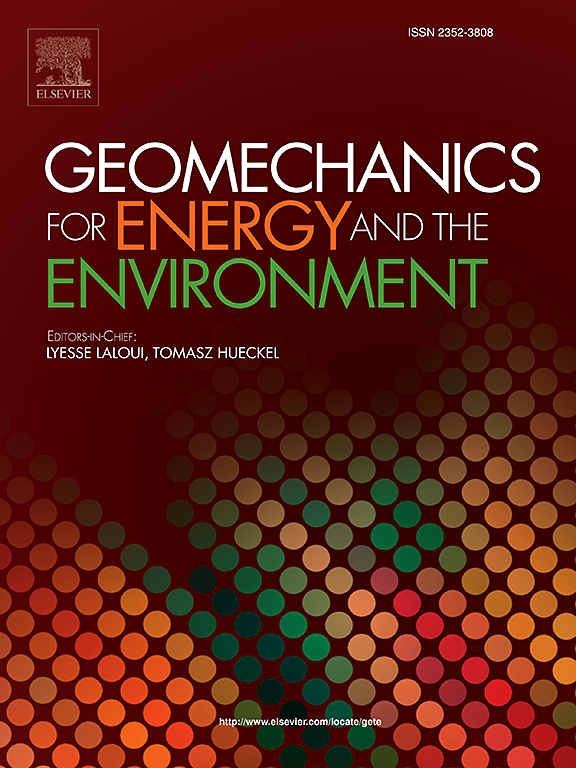Coupled hydro-gas-mechanical 3D modeling of LASGIT experiment
IF 3.3
2区 工程技术
Q3 ENERGY & FUELS
引用次数: 0
Abstract
Gas transport simulation in bentonite for radioactive waste disposal poses challenges for numerical models due to its complex microstructure. Understanding the processes involved is a prerequisite for assessing gas flow's impact on repository layouts. The DECOVALEX23 (D-2023) Task B (Large Scale Gas Injection Test: LASGIT) project aims to advance numerical techniques for predicting gas flow in repository systems through gas injection tests on compacted bentonite at the British Geological Survey (BGS). This study develops a comprehensive coupled hydro-gas-mechanical 3D numerical model to simulate the test, considering heterogeneous initial permeability and embedded fractures. Addressing bentonite swelling, three gap closure scenarios for the canister-bentonite blocks gap interface were considered. The model reproduces observed test behaviors, capturing preferential gas flow paths. Sensitivity analysis explores variations in volume factor sensitivity, calibration, hydraulic conductivity of interfaces, heterogeneity, permeability, and model parameters, contributing to a deeper understanding of the phenomenon's complexity. The proposed hydraulic modeling, enriched by considerations of gap closure states, predicts measured evolution of gas injection trends. suggesting reliability and potential applicability for similar conditions and facilitating a comprehensive analysis of its impact on gas testing processes. Additionally, the embedded fracture models underscore the critical role of fracture behavior and dilatancy in determining the system's hydro-mechanical response, with significant sensitivity to these factors influencing stress and pore pressure evolution. Hydro-mechanical models demonstrate that modeling approaches involving embedded fractures and dilatancy significantly influence gas pathways and entry gas pressure. System volume plays pivotal role in the analysis, while sensitivity analysis of contact transmissivity reveals potential influences on preferential gas pathway formation. Hydraulic and hydro-mechanical modeling methods show promise for further numerical investigations, indicating potential for yielding meaningful insights in future studies.
LASGIT实验的油气-力学耦合三维建模
放射性废物处理用膨润土中气体输运的模拟由于其复杂的微观结构给数值模型带来了挑战。了解所涉及的过程是评估气体流动对储存库布局影响的先决条件。DECOVALEX23 (D-2023)任务B(大规模注气试验:LASGIT)项目旨在通过在英国地质调查局(BGS)的压实膨润土上进行注气试验,推进预测储库系统中气体流动的数值技术。考虑非均质初始渗透率和嵌埋裂缝,建立了综合的水-气-力耦合三维数值模型。针对膨润土溶胀问题,考虑了罐-膨润土块间隙界面的三种闭合情况。该模型再现了观察到的测试行为,捕获了优先的气体流动路径。敏感性分析探讨了体积因子敏感性、校准、界面水力导电性、非均质性、渗透率和模型参数的变化,有助于更深入地理解现象的复杂性。所提出的水力模型在考虑了气隙闭合状态的基础上,预测了实测的注气演化趋势。建议类似条件下的可靠性和潜在适用性,并促进其对气体测试过程影响的全面分析。此外,嵌入裂缝模型强调了裂缝行为和剪胀在决定系统水力学响应中的关键作用,对这些影响应力和孔隙压力演化的因素具有显著的敏感性。流体力学模型表明,考虑嵌入裂缝和膨胀的建模方法对天然气通道和进入气体压力有显著影响。系统体积在分析中起关键作用,而接触透射率的敏感性分析揭示了对优先气路形成的潜在影响。水力和水力学建模方法显示出进一步数值研究的前景,表明有可能在未来的研究中产生有意义的见解。
本文章由计算机程序翻译,如有差异,请以英文原文为准。
求助全文
约1分钟内获得全文
求助全文
来源期刊

Geomechanics for Energy and the Environment
Earth and Planetary Sciences-Geotechnical Engineering and Engineering Geology
CiteScore
5.90
自引率
11.80%
发文量
87
期刊介绍:
The aim of the Journal is to publish research results of the highest quality and of lasting importance on the subject of geomechanics, with the focus on applications to geological energy production and storage, and the interaction of soils and rocks with the natural and engineered environment. Special attention is given to concepts and developments of new energy geotechnologies that comprise intrinsic mechanisms protecting the environment against a potential engineering induced damage, hence warranting sustainable usage of energy resources.
The scope of the journal is broad, including fundamental concepts in geomechanics and mechanics of porous media, the experiments and analysis of novel phenomena and applications. Of special interest are issues resulting from coupling of particular physics, chemistry and biology of external forcings, as well as of pore fluid/gas and minerals to the solid mechanics of the medium skeleton and pore fluid mechanics. The multi-scale and inter-scale interactions between the phenomena and the behavior representations are also of particular interest. Contributions to general theoretical approach to these issues, but of potential reference to geomechanics in its context of energy and the environment are also most welcome.
 求助内容:
求助内容: 应助结果提醒方式:
应助结果提醒方式:


